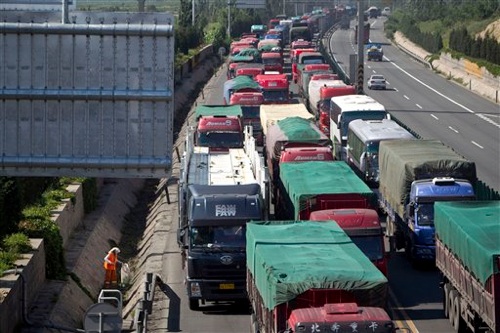The Great Jam of China

At times, sitting around, listening to the radio, seems like a great, relaxing idea — if you’re at home, on the couch. But in a car? That means you’re probably sitting in traffic, and traffic jams are a simply terrible experience.
But by and large, traffic jams aren’t very long. Sitting in traffic for an hour is rare; sitting in a jam for six hours virtually unheard of. The exception? The Beijing-Tibet Expressway in China, in August of 2010. How bad of an exception? The traffic jam went for well more than six hours. It lasted more than ten days.
On or around August 14, 2010, traffic started to gather on the Expressway over a 100 kilometer stretch — and failed to abate. Use of the highway had been steadily increasing for years, with the number of automobiles using this specific roadway increasing nearly 40% year over year. At the time, the road was 60% over capacity. With the increased use, the Chinese government understandably made expanding the Expressway’s capacity a priority, and, per the Wall Street Journal, began roadwork on August 13th of that year. But while the long-term effect of such construction would be to alleviate traffic, as anyone who has attempted to drive through a construction zone knows, the short-term effect is an increase in traffic.
And then things got worse. As reported by the Financial Times, all the little things started to happen — traffic accidents, broken-down vehicles, and the like — each one adding another minor slowdown, and collectively, making the terrible traffic jam unimaginably long. Many drivers were only able to travel one kilometer a day, and while officials tried to get cars off the main road and onto alternative routes, for some, this meant sitting on the Expressway for as many as five days.
With so many travelers (especially long-haul rigs carting coal from Mongolia to urban centers around China) effectively stranded together, an economy and subculture started to spring up. Drivers complained that residents of nearby towns were coming to the highway with instant noodles for sale, but at exorbitant prices which took advantage of the captive customer base; bottles of water, typically costing 1 yuan (about 15 cents) were being sold for 10 yuan. Per the Guardian, some were “passing the time with games of chess or cards,” while others “requested concerts be performed on roadside verges” — outlandish, perhaps, but no more so than sixty miles of automobiles collectively going nowhere.
By the end of the month, traffic abated quickly. As the Christian Science Monitor reported, by the twelfth day, traffic on the Expressway “vanished” with only “garden-variety” backups still occurring.
Bonus fact: If sitting in traffic seems like torture, moving right along may be worse — just ask comic-magician duo Penn and Teller. In 1995, the pair was set to release a video game for the Sega CD consisting of six mini-games, one of which was called “Desert Bus.” (The six-game pack was never released because the publisher went out of business before copies shipped.) Desert Bus, striving for realism, had simple rules: You were a bus driver. Your bus has a slight alignment problem, drifting right, and you had to drive your passengers on a straight, scenery-free road from Tucson, Arizona, to Las Vegas, Nevada (about 360 to 400 miles) at a constant speed of 45 miles per hour. To “beat” the game, one needed to drive the bus, without pausing, for the eight hours straight.
From the Archives: Red Light, Green Light: How North Korea deals with traffic (even though it has very little private car ownership in the first place).
Related: Penn & Teller’s How to Play in Traffic: The book has 4.3 stars on 18 reviews.
Image via LaughingSquid.
